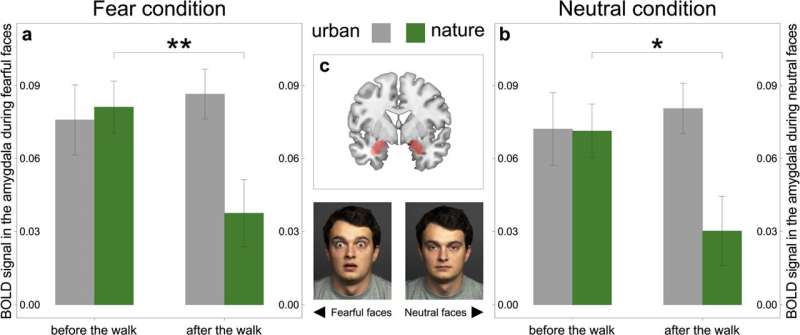How does nature nurture the brain?

After a 60-minute walk in nature, activity in brain regions involved in stress processing decreases. This is the finding of a recent study by the Lise Meitner Group for Environmental Neuroscience at the Max Planck Institute for Human Development, published in Molecular Psychiatry.
Living in a city is a well-known risk factor for developing a mental disorder, while living close to nature is largely beneficial for mental health and the brain. A central brain region involved in stress processing, the amygdala, has been shown to be less activated during stress in people who live in rural areas, compared to those who live in cities, hinting at the potential benefits of nature. "But so far the hen-and-egg problem could not be disentangled, namely whether nature actually caused the effects in the brain or whether the particular individuals chose to live in rural or urban regions," says Sonja Sudimac, predoctoral fellow in the Lise Meitner Group for Environmental Neuroscience and lead author of the study.
To achieve causal evidence, the researchers from the Lise Meitner Group for Environmental Neuroscience examined brain activity in regions involved in stress processing in 63 healthy volunteers before and after a one-hour walk in Grunewald forest or a shopping street with traffic in Berlin using functional magnetic resonance imaging (fMRI). The results of the study revealed that activity in the amygdala decreased after the walk in nature, suggesting that nature elicits beneficial effects on brain regions related to stress.
"The results support the previously assumed positive relationship between nature and brain health, but this is the first study to prove the causal link. Interestingly, the brain activity after the urban walk in these regions remained stable and did not show increases, which argues against a commonly held view that urban exposure causes additional stress," explains Simone Kühn, head of the Lise Meitner Group for Environmental Neuroscience.
The authors show that nature has a positive impact on brain regions involved in stress processing and that it can already be observed after a one-hour walk. This contributes to the understanding of how our physical living environment affects brain and mental health. Even a short exposure to nature decreases amygdala activity, suggesting that a walk in nature could serve as a preventive measure against developing mental health problems and buffering the potentially disadvantageous impact of the city on the brain.
The results go in line with a previous study (2017, Scientific Reports) which showed that city dwellers who lived close to the forest had a physiologically healthier amygdala structure and were therefore presumably better able to cope with stress. This new study again confirms the importance for urban design policies to create more accessible green areas in cities in order to enhance citizens' mental health and well-being.
In order to investigate beneficial effects of nature in different populations and age groups, the researchers are currently working on a study examining how a one-hour walk in natural versus urban environments impacts stress in mothers and their babies.
More information: Sonja Sudimac et al, How nature nurtures: Amygdala activity decreases as the result of a one-hour walk in nature, Molecular Psychiatry (2022). DOI: 10.1038/s41380-022-01720-6
Simone Kühn et al, In search of features that constitute an "enriched environment" in humans: Associations between geographical properties and brain structure, Scientific Reports (2017). DOI: 10.1038/s41598-017-12046-7




















